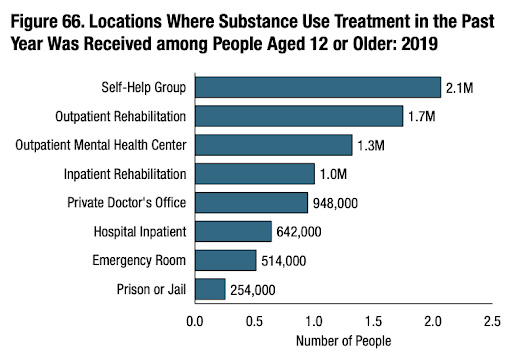Addiction treatment can be life-saving, both in the figurative and literal sense. It can put a stop to the compulsive drug use that destroys marriages and other important relationships, makes it impossible to hold a job, and leaves your finances in tatters. The behavioral and medical interventions of treatment can give your body a much-needed break from the ongoing abuse, preventing often fatal conditions such as cirrhosis, kidney failure, or cancer that would otherwise shave years off your lifespan. Yet despite how universally beneficial (and in many cases, desperately needed) drug rehab can be, many who struggle with addiction struggle even more with taking that leap and enrolling in treatment.
An Epidemic Within An Epidemic
According to the most recent data from SAMHSA’s annual substance abuse survey, in 2019 there were 21 million people who needed substance abuse treatment but little more than 4 million individuals sought or received treatment. These drastic numbers beg the question: Why do so many drug users fail to get help?
The reasons why so few individuals ever step foot into some sort of substance abuse treatment facility are as varied and multifaceted as the reasons why people use drugs in the first place. Some of these barriers to treatment are fairly obvious and understandable. Rehab can be costly in terms of time and money and a logistical nightmare that requires arranging for childcare, time off work, and transportation. These factors can be incredibly discouraging and no doubt contributed to why only 1% of those who recognized that they need treatment actually made an effort to seek it out.
The theme of the other main group of objections is a bit more shocking. A significant number of treatment barriers can be attributed to a simple lack of willingness. The vast majority of individuals with a substance abuse disorder either fail to recognize that they have a drug use problem (in 2019, 95.7% of individuals felt that they did not need treatment) or are reluctant to attend for fear of judgment from friends and family.
How 12 Step Programs Help Overcome Treatment Barriers
Twelve step programs such as Alcoholics Anonymous and the dozens upon dozens of similarly structured groups modeled after it are uniquely positioned to help bridge the gap between treatment barriers. Narcotics Anonymous, Dual Diagnosis Anonymous, Al-Anon, and the like are peer-based groups that offer a low-stakes means for treatment-hesitant individuals to get a peek at what life on the other side is like.
In 2019 these self-help groups were the most common source of substance abuse treatment amongst Americans aged 12 and older.

This is far from coincidence. There are a number of crucial factors that have led to 12 step programs being an attractive option to those who aren’t ready to commit to formal treatment at a specialty facility, these are the four biggest ones:
1. They’re Free
Arguably the largest barrier to receiving treatment is paying for it and is where 12 step programs shine. The majority of these types of recovery groups are free to attend, and many of the organizations that host these programs are often non-profits. That means there are never any fees to participate in Alcoholics Anonymous, whether you’re an established group member or otherwise.
2. They’re Confidential
Privacy is cited as another major concern by those who are reluctant to seek drug treatment. Many individuals express deep discomfort at the thought of being made to speak in front of others or being asked personal questions.
At 12 step meetings, there are no such obligations and you can instead simply listen to others. Should you choose to share, there is a strict emphasis on confidentiality to the degree that any admissions to crimes or other tales of questionable legality are safe to speak of without risk of persecution. Groups like AA also ensure your privacy is protected by purposefully prohibiting signup sheets or any other trace of your attendance, and welcoming the use of aliases to avoid using your real name.
3. There’s No Commitment
The thought of being away from home, from loved ones, the workplace, or in many cases, drugs, can be a major source of anxiety. As such, the thought of enrolling in rehab, which would likely involve restrictions on where you can go, who you can see, and access to drugs, is largely avoided. Twelve step programs, however, have no such commitments. These peer-based groups are structured around a walk-in policy where participants are welcome to come and go as they please, as frequently or infrequently as suits them.
4. They’re Everywhere
No matter how accommodating (or free) these programs might be, they won’t do much good if they’re difficult to access. Fortunately, peer-based groups also excel at accessibility, with many of these organizations having thousands of chapters all over the world. There are plenty of directories available to find nearby AA and other meetings, as well as online-hosted meetings that can circumvent any transportation challenges.
Taking Small Steps Towards Recovery
The nature of how 12 step programs are structured bypasses many of the most commonly cited reasons for avoiding treatment including financial limitations, time restrictions, and accessibility. More importantly, they do so in a manner that is minimally disruptive to the individual’s current lifestyle, promises anonymity, and requires zero commitment.
If you or a loved one is hesitant about making the leap, joining AA, NA, or other targeted substance abuse self-help group can help you find the motivation to eventually move on to formal treatment. And this isn’t an endeavor that addicted persons have to go through alone. These meetings are open to all, both drug users and non-drug users. They are the epitome of safe spaces that allow you to pursue recovery at your own pace and on your own terms.

I looking for gambling meeting in Ardmore okla